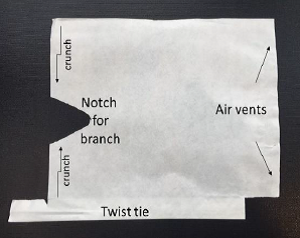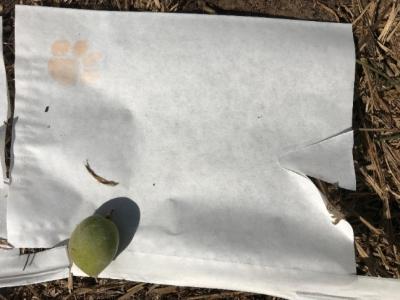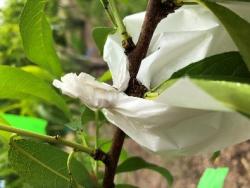eOrganic authors:
David Campbell, University of Florida
Danielle Treadwell, University of Florida
Juan Carlos Melgar, Clemson University
Dario Chavez, University of Georgia
Introduction
Peaches represent the largest increase in organic fruit acreage in the United States (Perez and Plattner, 2013). California, Washington, and Oregon currently supply the majority of domestic organic fresh market peaches (Hallberg, 2016). In 2014, 16,875 tons of organic peaches were produced in the United States, with over 79% of the total originating in California and Oregon (Perez and Plattner, 2013). Data from organic peach producers in the southeastern United States is largely unavailable due to USDA Agricultural Census reporting privacy policies and low production, but South Carolina and Georgia rank as the second and third largest conventional and organic peach-producing states behind California (USDA National Agricultural Statistics Service, 2017). Nationwide, producers select peach varieties based on chill requirements that range from less than 100 to over 1,000 hours and full-bloom dates that occur after the last potential freeze. In the Southeast, peach producers harvest fruit up to two months before West Coast producers, and meet market demands from April through September.
Organic peach production in the Southeast has been difficult due to the prevalence of insect and disease pests, as well as the lack of effective organically-approved pesticides (Horton et al, 2005; Blaauw et al., 2017). In addition, many of the compliant, commercially-available pesticides contain copper and other ingredients that may negatively impact soil health with overuse (USDA National Organic Standards Board, 2017). Pests and diseases can affect fruit quality throughout the entire growing season and at postharvest. For example, the insect pests green stinkbug (Chinavia halaris) feed, and plum curculio (Conotrachelus nenuphar) oviposit in fruit during initial growth development. Bacterial spot (Xanthomonas arboricola) and peach scab (Cladosporium carpophilum) cause unmarketable skin blemishes and spread when the humidity and temperature are optimum for growth. The most prevalent end-of-season and postharvest fungal diseases include brown rot (Monilinia fructicola) and rhizopus (Rhizopus nigricans).
Organic fruit producers in the United States, Spain, Japan, and China have been installing paper bags on fruitlets to provide a physical barrier from both pests and pathogens (Sharma et al., 2014). Research has shown that bagged fruit, as compared to a non-bagged control, can increase fruit quality and yield for a variety of crop-pest complexes (Table 1), but have shown mixed results for other characteristics (Table 2). Based on these results, researchers in the southeastern United States are currently evaluating bagging as a potential pest and disease management technique. In a pilot study funded by the Southern IPM Center, J. Melgar and G. Schnabel (publication forthcoming) demonstrated that bagging peaches increased the amount of marketable peaches in an organic orchard, and customers were willing to pay more for bagged peach fruit. Furthermore, preliminary calculations indicate that grower costs may increase around 10 to 15 cents per pound produced to cover the extra bagging cost (Hallberg, 2016).
Table 1. Insects and diseases that are controlled by bagging in conventional operations
| Fruit | Insect or Disease | Percent Controlled | Bag Type | Reference |
| Guava | Fruit fly (Anastrepha spp.), and Guava weevil (Conotrachelus psidii) | 51-70% | Bags constructed of biodegradable film | Blick et al., 2011 |
| Pomegranate | Anar butterfly (Deudorix Virachola) | 90% | Bag constructed of brown paper | Bagle, 2011 |
| Litchi | Stalk-end borer (Conopomorpha cramerella) and stone borer (Platypepla spp. and Conogethes spp.) | 80-97% | Bags of different color constructed of cellophane, brown paper and double-sided newspaper | Debnath and Mitra, 2008 |
| Mango | Anthracnose (Colletotrichum spp.) | 50-96% | Bags constructed of white paper | Hofman et al., 1997 |
Table 2. Influence of bagging on various fruit quality characteristics in conventional operations
| Fruit | Quality | Effect | Reference |
| Guava | Acidity | Increased | Blick et al., 2011 |
| Peach and Mango | Acidity | No effect | Jai et al., 2005 and Hofman et al., 1997 |
| Peach and Guava | Total soluble solids | Increased | Kim et al., 2008 and Singh et al., 2007 |
| Pear and plum | Total soluble solids | Decreased | Lin et al., 2008 and Murray et al., 2005 |
| Peach, Guava, and Mango | Total soluble solids | No effect | Blick et al., 2011; Jia et al., 2005; and Hofman et al., 1997 |
Bagging Protocol
In the Southeast, low-chill cultivars set fruit as early as February in Florida and as late as May in North Carolina. After the last potential frost event, flowers and fruitlets are removed, also referred to as thinned, to lower the fruit-to-leaf shoot ratio and promote larger sized fruits (Costa and Vizzotto, 2000). The bagging practice under current investigation is conducted after thinning and includes one or more applications of organic-approved pesticides to reduce insect damage and pathogen growth on fruitlets prior to bagging. Organic peach growers in the Southeast follow a variety of pest and disease management practices, including rotating sprays of pyganic acid and Keyplex Ecotrol® Plus along with other foliar fertilizers, or applying sulfur-based sprays and kaolin clay to control pathogens and deter pests. Currently, bagging (Video 1) is recommended within three days of an organic-approved pesticide application, or as early as the re-entry period starts, to maintain a lower pathogen count on the fruitlet surface.
On-farm bagging research trials with certified USDA organic or transitioning organic farmers in South Carolina, Georgia, and Florida were initiated in 2018, but only the Florida location is discussed below. In Florida, fruits were bagged 35 days after full bloom with a white paper bag impregnated with water-resistant wax (Fig. 1). After identifying the fruitlet (Fig. 2), the paper bag is opened and placed over the fruitlet with the notch straddling the branch (Video 1). At this time, the fruitlet should be completely enclosed in the bag, the branch should be snug with the notch, and the bag should extend past the fruiting branch. Next, the portion of the bag that is extending on the opposite side of the branch as the fruitlet is cinched in an accordion-like fashion and secured by a twist tie that is part of the bag. Next, the twist tie is rotated at least 360 degrees around the cinched paper and the secured bag should not rotate around the branch when slightly agitated (Fig. 3). The bag will remain on the branch for the duration of the growing season and removed or ripped open to increase light penetration and promote blush development (Kataoka and Beppu, 2004) at the end of the season. Depending on the bag material, the bags can be recycled after removing the twist tie.
Video 1: Peach Bagging. Video credit: David Campbell, University of Florida.

Figure 1. Fruit bag. Photo credit: Guido Schnabel, Clemson University.

Figure 2. Size of fruit relative to fruit bag. Photo credit: David Campbell, University of Florida.



Figure 3. Fruit bag properly installed. Photo credit: David Campbell, University of Florida.
Florida Research Methods and Preliminary Results
The UF/IFAS research team partnered with the USDA certified organic U-Pick McLean Family Farm in Central Florida. The experiment was arranged in a randomized block design that tested two factors—bagging (all fruit were bagged on a tree or not bagged) and tree ordinance (north, south, east, and west quadrants of the canopy). Twenty-four trees were divided into four replications based on trunk diameter. During the growing season, insect traps were installed, tree phenology was assessed, and disease assessments were conducted. Postharvest evaluations included fruit size, weight, insect damage, and postharvest rot progression. Postharvest data were analyzed using the glimmix procedure in SAS (version 9.4, Cary, NC) for main effects and interactions at a=0.05. The ordinance factor and all interactions were not significant. Bagging did not reduce yield and the average yield of 4,668 kg/ha (p = 0.739) were acceptable for this farm. Bagged fruit had less insect injury (p = 0.025), scab-like lesions (p < 0.001), and brown rot at three days postharvest (p = 0.017), and brown rot at 7 days postharvest p < 0.001). The experiment will be repeated and additional quality characteristics will be evaluated.
Funding: This paper was developed in part with funding from the USDA-OREI Project Number 2016-51300-25726.
Additional Resources
Clemson fruit bags are available at https://www.clemson.edu/extension/peach/commercial/diseases/clemsonfruitbags.html
References and Citations
- Bagle, B. G. 2011. Studies on varietal reaction, extent of damage and management of anar butterfly, Deudorix isocrates in pomegranate. Acta Horticulturae. 890:557–559. Available online at: https://www.actahort.org/members/showpdf?booknrarnr=890_78 (verified 27 April 2018).
- Blick, P. A., Roberto, S. R., Maria, V.E.G., and Yamashita, F. 2011. Efficacy of some biodegradable films as pre-harvest covering material for guava. Scientia Horticulturae. 130:341–343. Available online at: https://doi.org/10.1016/j.scienta.2011.06.011 (verified 27 April 2018).
- Blaauw, B., Brannen, P., Bellinger, B., Lockwood, D., and Ritchie, D. 2017. Southeastern peach, nectarine and plum pest management and culture guide. University of Georgia Extension. Bulletin 1171. Available online at: http://extension.uga.edu/publications/detail.html?number=B1171 (verified 14 Feb 2018).
- Costa, G. and Vizzotto, G. 2000. Fruit thinning of peach trees. Plant Growth Regulation. 31:113–119. Available online at: https://doi.org/10.1023/A:1006387605042 (verified 27 April 2018).
- Debnath, S. and Mitra, S.K. 2008. Panicle bagging for maturity regulation, quality improvement and fruit borer management in litchi (Litchi chinensis). Acta Horticulturae. 773:201–208. Available online at: https://doi.org/10.17660/ActaHortic.2008.773.29 (verified 27 April 2018).
- Hallberg, R. 2016. Organic peach-bagging project shows great promise. Growing Produce. 1 June 2016. Available online at: http://www.growingproduce.com/fruits/stone-fruit/organic-peach-bagging-project-shows-great-promise/ (verified 14 Feb 2018).
- Hofman, P. J., Smith, L. G., Joyce, D. C., Johnson, G. L., and Meiburg, G. F. 1997. Bagging of mango (Mangifera indica cv. ‘Keitt’) fruit influences fruit quality and mineral composition. Available online at: https://doi.org/10.1016/S0925-5214(97)00039-2 (verified 27 April 2018).
- Horton, D., Bellinger, B., Pettis, G. V., Brannen, P. M., and Mitchem, W. E. 2005. Pest management strategic plan for Eastern peaches. Available online at: https://ipmdata.ipmcenters.org/documents/pmsps/EastPeach.pdf (verified 26 Nov 2019).
- Jia, H. L, Araka, A., and Okamoto, G. 2005. Influence of fruit bagging on aroma volatiles and skin colouration of ‘Hakuho’ peach (Prunus persica Batsch). Postharvest Biology and Technology. 35, 61–68. Available online at: https://doi.org/10.1016/j.postharvbio.2004.06.004 (verified 27 April 2018).
- Kataoka, I. and Beppu, K. 2004. UV irradiance increases development of red skin color and anthocyanins in ‘Hakuho’ Peach. Hortscience. 39(6):1234-1237. Available online at: https://journals.ashs.org/hortsci/view/journals/hortsci/39/6/article-p1234.xml (verified 26 Nov 2019).
- Kim, Y. H., Kim, H. H., Youn, C. K, Kweon, S. J., Jung, H. J., and Lee, C. H. 2008. Effects of bagging material on fruit colouration and quality of ‘Janghowon Hwangdo’ peach. Acta Horticulturae. 772:81–86. Available online at: https://www.actahort.org/members/showpdf?booknrarnr=772_9 (verified 27 April 2018).
- Lin, J., Chang, Y., Yan, Z., and Li, X. 2008. Effects of bagging on the quality of pear fruit and pesticide residues. Acta Horticulturae. 772:315–318. Available online at: https://www.actahort.org/members/showpdf?booknrarnr=772_52 (verified 27 April 2018).
- Murray, X. J., Holcroft, D. M., Cook, N. C., and Wand, S.J.E. 2005. Postharvest quality of ‘Laetitia’ and ‘Songold’ (Prunus salicina Lindell) plums as affected by pre-harvest shading treatments. Postharvest Biology and Technology. 37:81–92. Available online at: https://doi.org/10.1016/j.postharvbio.2005.02.014 (verified 27 April 2018).
- Perez, A. and Plattner, K. 2013. Fruit and tree nuts outlook: Commodity highlight. Organic fruit and berries. USDA Economic Research Service. FTS-356SA. Available online at: https://www.ers.usda.gov/webdocs/publications/37053/41059_fts-356sa.pdf?v=0 (verified 11 Dec 2019).
- Sharma, R. R., Reddy, S.V.R., and Jhalegar, M. J. (2014). Pre-harvest fruit bagging: A useful approach for plant protection and improved post-harvest fruit quality. J. Hortic. Sci. Biotech. 89:101–113. Available online at: https://doi.org/10.1080/14620316.2014.11513055 (verified 27 April 2018).
- Singh, B. P, Singh, R. A., Singh, G., and Killadi, B. (2007). Response of bagging on maturity, ripening and storage behavior of winter guava. Acta Horticulturae. 735:597–601. Available online at: https://doi.org/10.17660/ActaHortic.2007.735.77 (verified 27 April 2018).
- United States Department of Agriculture, Agricultural Marketing Service. 2017. National Organic Standards Board materials subcommittee proposal 2017 research priorities. Available online at: https://www.ams.usda.gov/rules-regulations/organic/nosb (verified 14 Feb 2018).
- United States Department of Agriculture, National Agricultural Statistics Service. 2017. Noncitrus fruits and nuts 2016 summary. Available online at: https://www.nass.usda.gov/Publications/Todays_Reports/reports/ncit0617.pdf (verified 26 Nov 2019).



